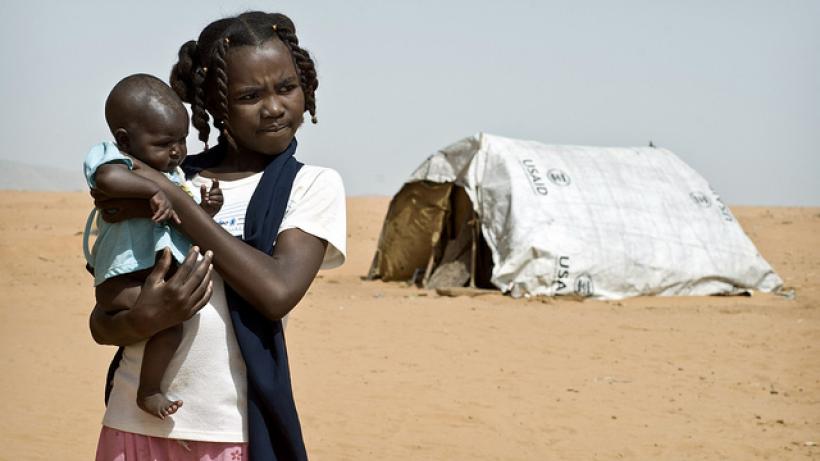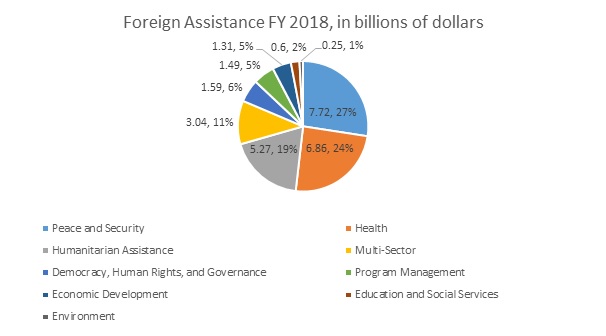
US foreign aid: How is it spent?
Angus Deaton argues that 3-5 million Americans are “as destitute as the world’s poorest people”, and wants us to adjust aid spending accordingly. His argument has flaws: he mixes data and ignores the fact that the US is already spending a lot more domestically than abroad.
In late January 2018, Angus Deaton, 2015 Nobel Prize winner for his work on welfare and poverty, made waves through an article in the New York Times. In this article, he looked at the World Bank’s poverty estimates on PovcalNet, which since October include high-income countries, and concluded that as of 2013 there are 3-5 million Americans who are absolutely poor by global standards. This is more (in absolute terms) than countries like Sierra Leone or Nepal. Given this high number, he questions prioritising “the faraway poor over the poor at home”.
Of course Deaton has a point - as the UN’s Philip Alston’s recent tour showed, extreme poverty is a real issue in the US. For example, the intestinal parasite hookworm was rediscovered in the Alabama, due to a lack of modern sanitation. However, there are a number of flaws with his argument that these 3-5 million are “as destitute as the world’s poorest people”.
-
He’s mixing different types of data
As pointed out by Kenny and Sandefur at CGD (Centre for Global Development), Deaton is not comparing like-for-like. Deaton is using the World Bank’s PovcalNet data, which uses income data for the US and consumption data for developing countries. But, as noted by the World Bank itself, poor people in high-income countries “generally have access to free public services and social transfers” which means that even if income is low, consumption levels are higher.
Using consumption measures from the US Consumption and Expenditure Survey, Kenny and Sandefur find a poverty rate of about 0.07%, or about 230,000 people living under $1.90 a day, much less than Deaton’s 3.2 million under this threshold. In fact, the World Bank itself assumes “zero poverty […] in most high-income countries” for this reason. So extreme poverty in the US is actually relatively low when using appropriate data, and given the US itself is probably best placed to address this, we should look at how the US tackles poverty abroad and at home, which leads us to flaw #2:
-
The US is already spending much more domestically
Deaton’s article seems to recommend reallocating spending from overseas development aid (ODA) to domestic spending. But as Ryan Briggs from Vox writes, US ODA is relatively small – various estimates[1] put it at around 1% of the federal budget (around $3.5-$4 trillion[2]). The broadest definition, including military and security assistance, puts it at 1.3%. Compare this to spending shares on social programs, as reported by the Congressional Budget Office for the last four months: 9.6% on Medicaid, 13.3% on Medicare, and 24.4% on Social Security.
Furthermore, foreign aid has already been cut significantly. According to a government website, planned foreign assistance in the financial year of 2018 is $28 billion, which is less than two-thirds of the 2017 level ($45 billion). It would be much more sensible to query policies like Trump’s “Harvest Box” proposal, which would replace half of food allowances with preselected foods.
-
Most US foreign aid is not directly aimed at poverty reduction
Deaton says “we have an obligation to assist the truly destitute”. In other words, we should give money to the poorest. In his view that includes some American citizens, so we should spend money on them too. But in practice, this is not how the US decides to allocate foreign aid. There is an excellent Congressional Research Service (CRS) report analysing this question, which shows that even in its foreign assistance, the US is largely targeting domestic interests.
The CRS gives three motivations for aid spending:
- National Security – This has been the predominant aim, initially to prevent communist influence and then, post-Cold War and following 9/11, as a counter-terrorism strategy. This is reflected in the comment made by the Secretary of Defence General Jim Mattis: “If you don’t fully fund the State Department, then I need to buy more ammunition”. And Deaton himself says, “official aid from the United States is mostly set by geopolitics”.
- Commercial interests – This is essentially promoting US exports and an improved economic environment
- Humanitarian concerns – This targets reducing human suffering. In other words, the US government is not only focusing on income poverty.
We can see these three motivations in how aid is split. As the CRS reports for 2015, 40% of aid was for long-term development, 15% humanitarian assistance, 35% military and security, and 10% political.
The chart below gives another split as given by a government website tracking foreign aid, which shows that the main spending item is peace and security, followed by health and humanitarian assistance. When Deaton criticises prioritising foreign over American poor, he seems to forget that a large part of US foreign aid is not actually focused on reducing poverty.
 Source: https://foreignassistance.gov/explore
Source: https://foreignassistance.gov/explore
In light of the recent Oxfam scandals, Deaton’s article provides easy ammunition for aid sceptics. But even Deaton agrees that there is such a thing as good aid, targeting health for example. He could be much more critical of US cuts to foreign aid, at the same time as criticising US inequality.
Footnotes
[1] Numeric measures for foreign assistance vary between sources, partly because they include and exclude elements such as military assistance, or record funds appropriated vs. disbursed by fiscal year - Congressional Research Service (2016)
[2] Office of Management and Budget https://www.whitehouse.gov/omb/historical-tables/ - Table 1.1 gives total US outlays by year, and as $3,981,554 for 2017
References
Centre for Global Development (26 January 2018), “Chart of the week #4: Angus Deaton and the location of poverty“, https://www.cgdev.org/blog/chart-week-4-angus-deaton-location-poverty
Congressional Budget Office (7 February 2018), “Monthly budget review for January 2018”,
https://www.cbo.gov/system/files/115th-congress-2017-2018/reports/53549-mbr.pdf
Congressional Research Service (17 June 2016), “Foreign aid: An introduction to U.S. programmes and policy“, https://fas.org/sgp/crs/row/R40213.pdf
Council for Foreign Relations (11 April 2017), “How does the US spend its foreign aid?”, https://www.cfr.org/backgrounder/how-does-us-spend-its-foreign-aid
Financial Times (12 October 2015), “Nobel prize winner Angus Deaton shares 3 big ideas”, https://www.ft.com/content/b60c2e76-70f0-11e5-ad6d-f4ed76f0900a
Foreign Assistance, (accessed February 2018), https://foreignassistance.gov/explore for current budget, https://foreignassistance.gov/learn/understanding-the-data for share of budget
The Guardian (5 September 2017), “Hookworm, a disease of extreme poverty, is thriving in the US south. Why?“, https://www.theguardian.com/us-news/2017/sep/05/hookworm-lowndes-county-alabama-water-waste-treatment-poverty
New York Times (24 January 2018), “The US can no longer hide from its deep poverty problem”, https://www.nytimes.com/2018/01/24/opinion/poverty-united-states.html
New York Times (13 February 2018), “Trump’s ‘Harvest Box’ isn’t viable in SNAP overhaul, officials say“, https://www.nytimes.com/2018/02/13/us/harvest-box-snap-food-stamps.html?rref=collection%2Ftimestopic%2FFederal%20Budget%20(U.S.)
Office of Management and Budget (accessed February 2018), “Historical tables”, https://www.whitehouse.gov/omb/historical-tables/
United Nations Human Rights (15 December 2017), “Statement on visit to the US, by Professor Philip Alston, United Nations Special Rapporteur on extreme poverty and human rights”, http://www.ohchr.org/EN/NewsEvents/Pages/DisplayNews.aspx?NewsID=22533&LangID=E
Vox (4 Feb 2018), “Millions of Americans as destitute as the world’s poorest? Don’t believe it.”, https://www.vox.com/the-big-idea/2018/2/1/16959634/millions-americans-destitute-2-day-worlds-poorest-deaton-aid
World Bank (2016), “Taking on inequality”, https://openknowledge.worldbank.org/bitstream/handle/10986/25078/9781464809583.pdf

